The Difficulty of Reading Under Dim Light Conditions Can Be Explained by
What you'll learn to exercise: explain the process of vision and how people see color and depth

Figure one. Our eyes have in sensory data that helps united states understand the earth around us. (credit "top left": modification of work by "rajkumar1220″/Flickr"; credit "peak correct": modification of work by Thomas Leuthard; credit "eye left": modification of work past Demietrich Bakery; credit "middle right": modification of work by "kaybee07″/Flickr; credit "bottom left": modification of work by "Isengardt"/Flickr; credit "bottom right": modification of work past Willem Heerbaart)
The visual organization constructs a mental representation of the world effectually usa. This contributes to our power to successfully navigate through physical space and collaborate with of import individuals and objects in our environments. This section will provide an overview of the basic anatomy and function of the visual system. In add-on, you lot'll explore our ability to perceive color and depth.
Learning Objectives
- Describe the basic anatomy of the visual system
- Describe how light waves enable vision
- Draw the trichromatic theory of colour vision and the opponent-process theory
- Draw how monocular and binocular cues are used in the perception of depth
Anatomy of the Visual Organization
The eye is the major sensory organ involved in vision (Figure 1). Light waves are transmitted across the cornea and enter the eye through the pupil. The cornea is the transparent covering over the heart. Information technology serves as a barrier between the inner heart and the outside globe, and it is involved in focusing light waves that enter the heart. The pupil is the small opening in the eye through which light passes, and the size of the student can change as a function of light levels as well equally emotional arousal. When low-cal levels are low, the student will become dilated, or expanded, to permit more light to enter the eye. When calorie-free levels are high, the educatee volition constrict, or become smaller, to reduce the amount of light that enters the center. The pupil'due south size is controlled by muscles that are connected to the iris, which is the colored portion of the middle.
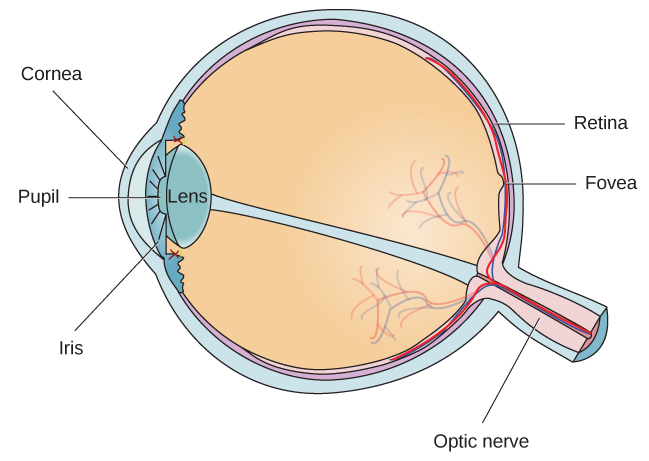
Figure 2. The anatomy of the eye is illustrated in this diagram.
Later passing through the pupil, low-cal crosses the lens, a curved, transparent construction that serves to provide additional focus. The lens is attached to muscles that tin can change its shape to aid in focusing light that is reflected from near or far objects. In a normal-sighted individual, the lens will focus images perfectly on a small indentation in the back of the eye known as the fovea, which is part of the retina, the calorie-free-sensitive lining of the heart. The fovea contains densely packed specialized photoreceptor cells. These photoreceptor cells, known as cones, are light-detecting cells. The cones are specialized types of photoreceptors that work all-time in brilliant light weather. Cones are very sensitive to acute particular and provide tremendous spatial resolution. They too are directly involved in our ability to perceive color.
While cones are concentrated in the fovea, where images tend to be focused, rods, some other blazon of photoreceptor, are located throughout the remainder of the retina. Rods are specialized photoreceptors that piece of work well in low light atmospheric condition, and while they lack the spatial resolution and colour function of the cones, they are involved in our vision in dimly lit environments equally well as in our perception of movement on the periphery of our visual field.

Figure 3. The two types of photoreceptors are shown in this prototype. Rods are colored green and cones are bluish.
We have all experienced the different sensitivities of rods and cones when making the transition from a brightly lit surround to a dimly lit environment. Imagine going to see a blockbuster picture show on a clear summer solar day. As yous walk from the brightly lit antechamber into the dark theater, y'all find that you immediately accept difficulty seeing much of anything. Subsequently a few minutes, you begin to suit to the darkness and can come across the interior of the theater. In the brilliant environment, your vision was dominated primarily by cone activeness. As you motility to the dark environs, rod activity dominates, merely there is a filibuster in transitioning between the phases. If your rods practice non transform lite into nerve impulses as hands and efficiently equally they should, you will accept difficulty seeing in dim low-cal, a condition known every bit night blindness.
Rods and cones are connected (via several interneurons) to retinal ganglion cells. Axons from the retinal ganglion cells converge and exit through the dorsum of the eye to form the optic nervus. The optic nerve carries visual data from the retina to the encephalon. There is a point in the visual field called the blind spot: Fifty-fifty when low-cal from a modest object is focused on the blind spot, we exercise not see it. Nosotros are not consciously aware of our blind spots for 2 reasons: Offset, each center gets a slightly dissimilar view of the visual field; therefore, the bullheaded spots exercise non overlap. 2nd, our visual arrangement fills in the blind spot and then that although we cannot reply to visual information that occurs in that portion of the visual field, we are also not aware that information is missing.
Effort It
The optic nervus from each eye merges merely below the encephalon at a bespeak called the optic chiasm. Equally Figure 3 shows, the optic chiasm is an X-shaped structure that sits just below the cognitive cortex at the front end of the brain. At the point of the optic chiasm, information from the correct visual field (which comes from both eyes) is sent to the left side of the brain, and data from the left visual field is sent to the right side of the brain.
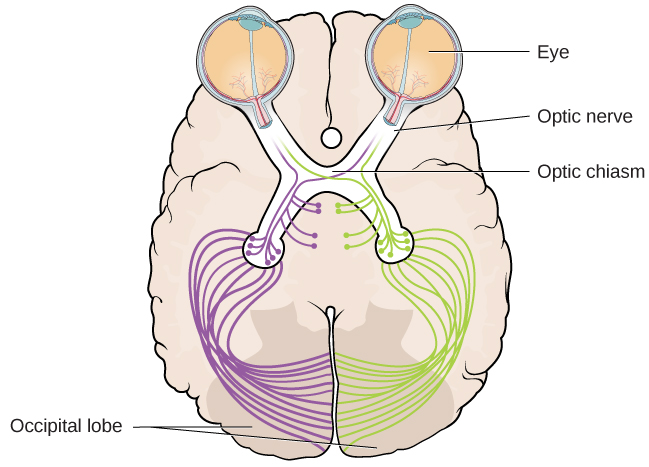
Figure 3. This illustration shows the optic chiasm at the front of the brain and the pathways to the occipital lobe at the back of the brain, where visual sensations are processed into meaningful perceptions.
Once inside the encephalon, visual information is sent via a number of structures to the occipital lobe at the back of the brain for processing. Visual information might be processed in parallel pathways which tin generally be described as the "what pathway" (the ventral pathway) and the "where/how" pathway (the dorsal pathway). The "what pathway" is involved in object recognition and identification, while the "where/how pathway" is involved with location in infinite and how i might interact with a detail visual stimulus (Milner & Goodale, 2008; Ungerleider & Haxby, 1994). For instance, when you lot come across a brawl rolling down the street, the "what pathway" identifies what the object is, and the "where/how pathway" identifies its location or movement in space.

Figure 4. Visual areas in the brain.
Effort It
Aamplitude and Wavelength
As mentioned above, light enters your optics as a moving ridge. It is important to sympathise some basic properties of waves to see how they impact what we see. Two physical characteristics of a wave are amplitude and wavelength (Figure v). The amplitude of a wave is the height of a wave equally measured from the highest point on the wave (peak or crest) to the lowest point on the wave (trough). Wavelength refers to the length of a wave from one summit to the next.
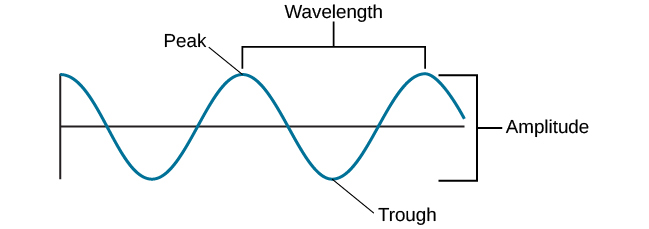
Figure 5. The amplitude or tiptop of a wave is measured from the peak to the trough. The wavelength is measured from height to peak.
Wavelength is straight related to the frequency of a given wave form. Frequency refers to the number of waves that pass a given point in a given time period and is often expressed in terms of hertz (Hz), or cycles per second. Longer wavelengths volition have lower frequencies, and shorter wavelengths will accept higher frequencies (Effigy 6).
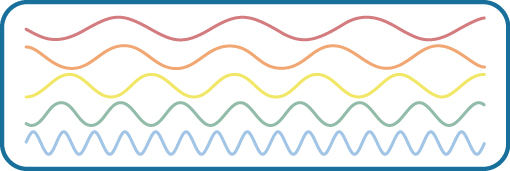
Effigy 6. This figure illustrates waves of differing wavelengths/frequencies. At the top of the figure, the red moving ridge has a long wavelength/brusk frequency. Moving from meridian to bottom, the wavelengths decrease and frequencies increase.
Light Waves
The visible spectrum is the portion of the larger electromagnetic spectrum that nosotros can run into. Every bit Figure 7 shows, the electromagnetic spectrum encompasses all of the electromagnetic radiation that occurs in our surround and includes gamma rays, x-rays, ultraviolet lite, visible calorie-free, infrared light, microwaves, and radio waves. The visible spectrum in humans is associated with wavelengths that range from 380 to 740 nm—a very small distance, since a nanometer (nm) is i billionth of a meter. Other species can detect other portions of the electromagnetic spectrum. For instance, honeybees tin can see light in the ultraviolet range (Wakakuwa, Stavenga, & Arikawa, 2007), and some snakes can notice infrared radiations in addition to more traditional visual lite cues (Chen, Deng, Brauth, Ding, & Tang, 2012; Hartline, Kass, & Loop, 1978).
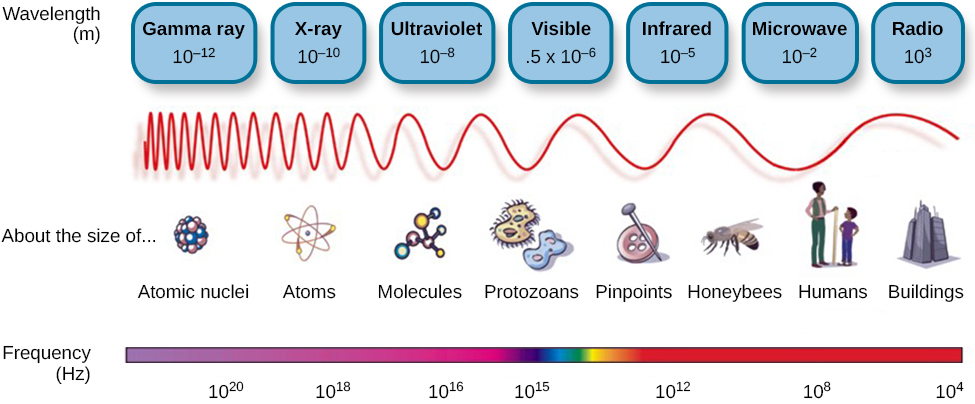
Effigy 7. Light that is visible to humans makes upwards simply a small portion of the electromagnetic spectrum.
In humans, light wavelength is associated with perception of color (Figure 8). Within the visible spectrum, our experience of ruddy is associated with longer wavelengths, greens are intermediate, and blues and violets are shorter in wavelength. (An easy way to recall this is the mnemonic ROYGBIV: red, orange, yellow, thousandreen, blue, indigo, violet.) The amplitude of light waves is associated with our experience of brightness or intensity of color, with larger amplitudes appearing brighter.

Effigy viii. Different wavelengths of light are associated with our perception of different colors. (credit: modification of work by Johannes Ahlmann)
Try It
We practise not encounter the earth in black and white; neither do we encounter it as two-dimensional (2-D) or apartment (just height and width, no depth). Let'southward look at how color vision works and how nosotros perceive three dimensions (height, width, and depth).
Color Vision
Normal-sighted individuals have iii different types of cones that mediate color vision. Each of these cone types is maximally sensitive to a slightly dissimilar wavelength of light. Co-ordinate to the Young-Helmholtztrichromatic theory of color vision, shown in Figure ix, all colors in the spectrum can be produced by combining scarlet, green, and blueish. The three types of cones are each receptive to one of the colors.

Figure 9. This effigy illustrates the unlike sensitivities for the iii cone types found in a normal-sighted private. (credit: modification of work past Vanessa Ezekowitz)
The trichromatic theory of color vision is non the only theory—another major theory of color vision is known as the opponent-procedure theory. According to this theory, colour is coded in opponent pairs: black-white, yellow-blue, and green-red. The basic idea is that some cells of the visual arrangement are excited by one of the opponent colors and inhibited past the other. So, a cell that was excited by wavelengths associated with greenish would be inhibited by wavelengths associated with red, and vice versa. One of the implications of opponent processing is that we exercise not experience green-reds or yellowish-blues as colors. Some other implication is that this leads to the experience of negative afterimages. An afterimage describes the continuation of a visual sensation afterward removal of the stimulus. For example, when you stare briefly at the sun and then look away from information technology, you may still perceive a spot of lite although the stimulus (the sunday) has been removed. When color is involved in the stimulus, the colour pairings identified in the opponent-process theory lead to a negative afterimage. Y'all tin test this concept using the flag in Figure 10.

Figure x. Stare at the white dot for 30–threescore seconds and then motion your eyes to a blank piece of white newspaper. What practise you meet? This is known as a negative afterimage, and it provides empirical support for the opponent-process theory of colour vision.
But these ii theories—the trichromatic theory of color vision and the opponent-process theory—are not mutually sectional. Research has shown that they just apply to unlike levels of the nervous organisation. For visual processing on the retina, trichromatic theory applies: the cones are responsive to three different wavelengths that correspond red, blue, and dark-green. But in one case the point moves by the retina on its manner to the brain, the cells answer in a mode consequent with opponent-process theory (Land, 1959; Kaiser, 1997).
Try It
Depth Perception
Our ability to perceive spatial relationships in three-dimensional (3-D) space is known as depth perception. With depth perception, we can describe things equally being in front end, behind, higher up, below, or to the side of other things.
Our world is three-dimensional, so information technology makes sense that our mental representation of the earth has three-dimensional properties. We use a variety of cues in a visual scene to establish our sense of depth. Some of these are binocular cues, which means that they rely on the utilise of both optics. I case of a binocular depth cue is binocular disparity, the slightly different view of the globe that each of our eyes receives. To feel this slightly different view, do this simple exercise: extend your arm fully and extend i of your fingers and focus on that finger. Now, shut your left eye without moving your head, then open your left center and close your right eye without moving your head. Y'all will notice that your finger seems to shift equally yous alternate between the two eyes because of the slightly different view each centre has of your finger.
A iii-D pic works on the same principle: the special glasses you vesture allow the two slightly different images projected onto the screen to exist seen separately by your left and your right eye. As your brain processes these images, you have the illusion that the leaping animal or running person is coming right toward you.
Although we rely on binocular cues to feel depth in our 3-D world, we tin can also perceive depth in 2-D arrays. Think about all the paintings and photographs you have seen. Generally, you pick up on depth in these images even though the visual stimulus is ii-D. When we do this, we are relying on a number of monocular cues, or cues that require only ane eye. If you lot think you tin't meet depth with i eye, annotation that y'all don't bump into things when using only one eye while walking—and, in fact, we have more than monocular cues than binocular cues.
Watch It
The following video of anamorphic fine art demonstrates how nosotros rely on these monocular cues to run into depth, even when the depth is simply imagined.
An example of a monocular cue would exist what is known as linear perspective. Linear perspective refers to the fact that we perceive depth when nosotros see two parallel lines that seem to converge in an image (Effigy 11). Some other monocular depth cues are interposition, the partial overlap of objects, the relative size and closeness of images to the horizon, relative size, and the variation between low-cal and shadow.

Effigy 11. Nosotros perceive depth in a two-dimensional effigy like this one through the use of monocular cues similar linear perspective, like the parallel lines converging as the road narrows in the altitude. (credit: Marc Dalmulder)
Dig Deeper: Stereoblindness
Bruce Bridgeman was built-in with an extreme example of lazy middle that resulted in him being stereoblind, or unable to respond to binocular cues of depth. He relied heavily on monocular depth cues, just he never had a true appreciation of the iii-D nature of the globe around him. This all inverse one night in 2012 while Bruce was seeing a movie with his married woman.
The movie the couple was going to see was shot in 3-D, and even though he idea information technology was a waste of money, Bruce paid for the three-D glasses when he purchased his ticket. Equally soon equally the moving-picture show began, Bruce put on the glasses and experienced something completely new. For the outset time in his life he appreciated the true depth of the earth around him. Remarkably, his ability to perceive depth persisted outside of the movie theater.
There are cells in the nervous system that answer to binocular depth cues. Normally, these cells crave activation during early evolution in guild to persist, so experts familiar with Bruce'southward case (and others like his) assume that at some indicate in his development, Bruce must have experienced at to the lowest degree a fleeting moment of binocular vision. It was plenty to ensure the survival of the cells in the visual system tuned to binocular cues. The mystery now is why it took Bruce nearly 70 years to have these cells activated (Peck, 2012).
Integration with Other Modalities
Vision is not an encapsulated system. It interacts with and depends on other sensory modalities. For example, when y'all move your caput in one management, your eyes reflexively move in the contrary direction to recoup, assuasive you to maintain your gaze on the object that you are looking at. This reflex is chosen the vestibulo-ocular reflex. It is achieved by integrating information from both the visual and the vestibular organisation (which knows near trunk movement and position). You can experience this compensation quite simply. First, while you keep your caput nonetheless and your gaze looking straight ahead, moving ridge your finger in forepart of you from side to side. Notice how the image of the finger appears blurry. At present, keep your finger steady and look at information technology while you movement your head from side to side. Detect how your eyes reflexively move to compensate the movement of your head and how the paradigm of the finger stays sharp and stable. Vision likewise interacts with your proprioceptive system, to assist you find where all your body parts are, and with your auditory system, to help yous understand the sounds people make when they speak. You can learn more about this in the multimodal module.
Finally, vision is also often implicated in a blending-of-sensations miracle known assynesthesia. Synesthesia occurs when i sensory signal gives rising to ii or more sensations. The almost common blazon is character-colour synesthesia. About 1 in 200 individuals experience a sensation of color associated with specific messages, numbers, or words: the number 1 might ever be seen as ruby-red, the number 2 equally orange, etc. Just the more fascinating forms of synesthesia alloy sensations from entirely dissimilar sensory modalities, like taste and color or music and color: the taste of chicken might elicit a sensation of green, for example, and the timbre of violin a deep purple.
Sensation and PErception
All of this talk about vision may have you wondering what this has to practice with psychology. Remember that awareness is input almost the concrete world obtained past our sensory receptors, and perception is the process by which the brain selects, organizes, and interprets these sensations. In other words, senses are the physiological basis of perception. Perception of the same senses may vary from one person to another because each person'south brain interprets stimuli differently based on that individual'due south learning, memory, emotions, and expectations. It is for this reason that psychologists study awareness—in order to understand perception, which is clearly a component of beliefs and mental processes (the definition of psychology).
Think It Over
Have a await at a few of your photos or personal works of art. Tin you lot find examples of linear perspective as a potential depth cue?
Glossary
amplitude:height of a wave
afterimage:continuation of a visual sensation afterwards removal of the stimulus
binocular cue:cue that relies on the use of both optics
binocular disparity:slightly different view of the earth that each eye receives
blind spot:signal where we cannot respond to visual data in that portion of the visual field
cone:specialized photoreceptor that works all-time in brilliant light conditions and detects color
cornea:transparent covering over the eye
depth perception:ability to perceive depth
electromagnetic spectrum: all the electromagnetic radiations that occurs in our environment
fovea:small indentation in the retina that contains cones
frequency:number of waves that pass a given point in a given time period
hertz (Hz):cycles per second; measure of frequency
iris:colored portion of the heart
lens:curved, transparent structure that provides additional focus for light entering the heart
linear perspective:perceive depth in an image when two parallel lines seem to converge
monocular cue:cue that requires only one eye
opponent-process theory of colour perception:color is coded in opponent pairs: blackness-white, yellow-blue, and ruby-dark-green
optic chiasm:Ten-shaped structure that sits but below the encephalon'southward ventral surface; represents the merging of the optic nerves from the 2 eyes and the separation of data from the two sides of the visual field to the opposite side of the brain
optic nerve:carries visual information from the retina to the encephalon
superlative:(besides, crest) highest signal of a moving ridge
photoreceptor:light-detecting cell
educatee:small opening in the eye through which lite passes
retina:light-sensitive lining of the centre
rod:specialized photoreceptor that works well in low low-cal weather
synesthesia: the blending of ii or more sensory experiences, or the automatic activation of a secondary (indirect) sensory experience due to certain aspects of the primary (direct) sensory stimulation
trichromatic theory of color perception:color vision is mediated by the activeness across the 3 groups of cones
trough:everyman point of a wave
vestibulo-ocular reflex: coordination of motion information with visual data that allows you to maintain your gaze on an object while you move
visible spectrum:portion of the electromagnetic spectrum that we can see
wavelength:length of a wave from one meridian to the next peak
Source: https://courses.lumenlearning.com/wmopen-psychology/chapter/outcome-vision/
0 Response to "The Difficulty of Reading Under Dim Light Conditions Can Be Explained by"
Post a Comment